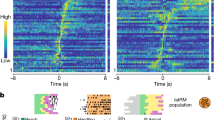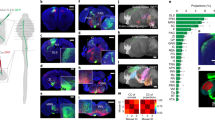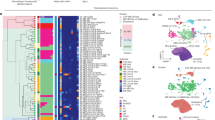Abstract
Translating the behavioural output of the nervous system into movement involves interaction between brain and spinal cord. The brainstem provides an essential bridge between the two structures, but circuit-level organization and function of this intermediary system remain poorly understood. Here we use intersectional virus tracing and genetic strategies in mice to reveal a selective synaptic connectivity matrix between brainstem substructures and functionally distinct spinal motor neurons that regulate limb movement. The brainstem nucleus medullary reticular formation ventral part (MdV) stands out as specifically targeting subpopulations of forelimb-innervating motor neurons. Its glutamatergic premotor neurons receive synaptic input from key upper motor centres and are recruited during motor tasks. Selective neuronal ablation or silencing experiments reveal that MdV is critically important specifically for skilled motor behaviour, including accelerating rotarod and single-food-pellet reaching tasks. Our results indicate that distinct premotor brainstem nuclei access spinal subcircuits to mediate task-specific aspects of motor programs.
This is a preview of subscription content, access via your institution
Access options
Subscribe to this journal
Receive 51 print issues and online access
$199.00 per year
only $3.90 per issue
Buy this article
- Purchase on Springer Link
- Instant access to full article PDF
Prices may be subject to local taxes which are calculated during checkout






Similar content being viewed by others
References
Shik, M. L. & Orlovsky, G. N. Neurophysiology of locomotor automatism. Physiol. Rev. 56, 465–501 (1976)
Orlovsky, G. N., Deliagina, T. G. & Grillner, S. Neuronal Control of Locomotion: From Mollusc to Man (Oxford Univ. Press, 1999)
Grillner, S. Biological pattern generation: the cellular and computational logic of networks in motion. Neuron 52, 751–766 (2006)
Jordan, L. M., Liu, J., Hedlund, P. B., Akay, T. & Pearson, K. G. Descending command systems for the initiation of locomotion in mammals. Brain Res. Rev. 57, 183–191 (2008)
Kuypers, H. G. J. M. in Handbook of Physiology: The Nervous System. Anatomy of the Descending Pathways 597–666 (American Physiological Society, 1981)
Lemon, R. N. Descending pathways in motor control. Annu. Rev. Neurosci. 31, 195–218 (2008)
Rathelot, J. A. & Strick, P. L. Subdivisions of primary motor cortex based on cortico-motoneuronal cells. Proc. Natl Acad. Sci. USA 106, 918–923 (2009)
Alstermark, B. & Isa, T. Circuits for skilled reaching and grasping. Annu. Rev. Neurosci. 35, 559–578 (2012)
Iwaniuk, A. N. & Whishaw, I. Q. On the origin of skilled forelimb movements. Trends Neurosci. 23, 372–376 (2000)
Mori, S., Sakamoto, T., Ohta, Y., Takakusaki, K. & Matsuyama, K. Site-specific postural and locomotor changes evoked in awake, freely moving intact cats by stimulating the brainstem. Brain Res. 505, 66–74 (1989)
Noga, B. R., Kriellaars, D. J., Brownstone, R. M. & Jordan, L. M. Mechanism for activation of locomotor centers in the spinal cord by stimulation of the mesencephalic locomotor region. J. Neurophysiol. 90, 1464–1478 (2003)
Skinner, R. D. & Garcia-Rill, E. The mesencephalic locomotor region (MLR) in the rat. Brain Res. 323, 385–389 (1984)
Garcia-Rill, E. & Skinner, R. D. The mesencephalic locomotor region. I. Activation of a medullary projection site. Brain Res. 411, 1–12 (1987)
Drew, T., Prentice, S. & Schepens, B. Cortical and brainstem control of locomotion. Prog. Brain Res. 143, 251–261 (2004)
Holmqvist, B. & Lundberg, A. Differential supraspinal control of synaptic actions evoked by volleys in the flexion reflex afferents in alpha motoneurones. Acta Physiol. Scand. Suppl. 186, 1–15 (1961)
Grillner, S. & Hongo, T. Vestibulospinal effects on motoneurones and interneurones in the lumbosacral cord. Prog. Brain Res. 37, 243–262 (1972)
Jankowska, E., Hammar, I., Slawinska, U., Maleszak, K. & Edgley, S. A. Neuronal basis of crossed actions from the reticular formation on feline hindlimb motoneurons. J. Neurosci. 23, 1867–1878 (2003)
Jankowska, E. & Edgley, S. A. How can corticospinal tract neurons contribute to ipsilateral movements? A question with implications for recovery of motor functions. Neuroscientist 12, 67–79 (2006)
Wickersham, I. R. et al. Monosynaptic restriction of transsynaptic tracing from single, genetically targeted neurons. Neuron 53, 639–647 (2007)
Wickersham, I. R., Sullivan, H. A. & Seung, H. S. Production of glycoprotein-deleted rabies viruses for monosynaptic tracing and high-level gene expression in neurons. Nature Protocols 5, 595–606 (2010)
Ugolini, G. Advances in viral transneuronal tracing. J. Neurosci. Methods 194, 2–20 (2010)
Stepien, A. E., Tripodi, M. & Arber, S. Monosynaptic rabies virus reveals premotor network organization and synaptic specificity of cholinergic partition cells. Neuron 68, 456–472 (2010)
Tripodi, M., Stepien, A. E. & Arber, S. Motor antagonism exposed by spatial segregation and timing of neurogenesis. Nature 479, 61–66 (2011)
Paxinos, G. & Franklin, K. B. The Mouse Brain in Stereotaxic Coordinates 4th edn (Elsevier, 2012)
Vong, L. et al. Leptin action on GABAergic neurons prevents obesity and reduces inhibitory tone to POMC neurons. Neuron 71, 142–154 (2011)
Pecho-Vrieseling, E., Sigrist, M., Yoshida, Y., Jessell, T. M. & Arber, S. Specificity of sensory-motor connections encoded by Sema3e–Plxnd1 recognition. Nature 459, 842–846 (2009)
McKenna, J. E., Prusky, G. T. & Whishaw, I. Q. Cervical motoneuron topography reflects the proximodistal organization of muscles and movements of the rat forelimb: a retrograde carbocyanine dye analysis. J. Comp. Neurol. 419, 286–296 (2000)
Greene, E. C. Anatomy of the Rat (Hafner, 1935)
Wall, N. R., Wickersham, I. R., Cetin, A., De La Parra, M. & Callaway, E. M. Monosynaptic circuit tracing in vivo through Cre-dependent targeting and complementation of modified rabies virus. Proc. Natl Acad. Sci. USA 107, 21848–21853 (2010)
Gorski, J. A. et al. Cortical excitatory neurons and glia, but not GABAergic neurons, are produced in the Emx1-expressing lineage. J. Neurosci. 22, 6309–6314 (2002)
Buitrago, M. M., Schulz, J. B., Dichgans, J. & Luft, A. R. Short and long-term motor skill learning in an accelerated rotarod training paradigm. Neurobiol. Learn. Mem. 81, 211–216 (2004)
Yang, G., Pan, F. & Gan, W. B. Stably maintained dendritic spines are associated with lifelong memories. Nature 462, 920–924 (2009)
Costa, R. M., Cohen, D. & Nicolelis, M. A. Differential corticostriatal plasticity during fast and slow motor skill learning in mice. Curr. Biol. 14, 1124–1134 (2004)
Bretzner, F. & Brownstone, R. M. Lhx3-Chx10 reticulospinal neurons in locomotor circuits. J. Neurosci. 33, 14681–14692 (2013)
Buch, T. et al. A Cre-inducible diphtheria toxin receptor mediates cell lineage ablation after toxin administration. Nature Methods 2, 419–426 (2005)
Ruediger, S. et al. Learning-related feedforward inhibitory connectivity growth required for memory precision. Nature 473, 514–518 (2011)
Atasoy, D., Betley, J. N., Su, H. H. & Sternson, S. M. Deconstruction of a neural circuit for hunger. Nature 488, 172–177 (2012)
Magnus, C. J. et al. Chemical and genetic engineering of selective ion channel-ligand interactions. Science 333, 1292–1296 (2011)
Xu, T. et al. Rapid formation and selective stabilization of synapses for enduring motor memories. Nature 462, 915–919 (2009)
Whishaw, I. Q. & Pellis, S. M. The structure of skilled forelimb reaching in the rat: a proximally driven movement with a single distal rotatory component. Behav. Brain Res. 41, 49–59 (1990)
Blanco, J. E., Anderson, K. D. & Steward, O. Recovery of forepaw gripping ability and reorganization of cortical motor control following cervical spinal cord injuries in mice. Exp. Neurol. 203, 333–348 (2007)
Bui, T. V. et al. Circuits for grasping: spinal dI3 interneurons mediate cutaneous control of motor behavior. Neuron 78, 191–204 (2013)
Kiehn, O. Development and functional organization of spinal locomotor circuits. Curr. Opin. Neurobiol. 21, 100–109 (2011)
Goulding, M. Circuits controlling vertebrate locomotion: moving in a new direction. Nature Rev. Neurosci. 10, 507–518 (2009)
Yakovenko, S., Krouchev, N. & Drew, T. Sequential activation of motor cortical neurons contributes to intralimb coordination during reaching in the cat by modulating muscle synergies. J. Neurophysiol. 105, 388–409 (2011)
Hyland, B. I. & Jordan, V. M. Muscle activity during forelimb reaching movements in rats. Behav. Brain Res. 85, 175–186 (1997)
Roh, J., Cheung, V. C. & Bizzi, E. Modules in the brain stem and spinal cord underlying motor behaviors. J. Neurophysiol. 106, 1363–1378 (2011)
Zeilhofer, H. U. et al. Glycinergic neurons expressing enhanced green fluorescent protein in bacterial artificial chromosome transgenic mice. J. Comp. Neurol. 482, 123–141 (2005)
Harris, J. A., Oh, S. W. & Zeng, H. Adeno-associated viral vectors for anterograde axonal tracing with fluorescent proteins in nontransgenic and Cre driver mice. Curr. Protoc. Neurosci. 59, 1.20.1–1.20.18 (2012)
Acknowledgements
We are grateful to M. Mielich, B. Rapp, D. Salvador and M. Sigrist for expert technical help, L. Gelman, A. Ponti, N. Ehrenfeuchter, M. Kirschmann and R. Thierry for help and advice with image acquisition and analysis, and to P. Caroni for discussions and comments on the manuscript. We thank F. Donato, Y. Zuo, A. Takeoka, P. Tovote and P. Botta for advice on design of behavioral experiments, and S. Sternson for providing PSEM308 and advice for neuronal silencing experiments. M.S.E. was supported by a long-term fellowship of the Human Frontier Science Program, and all authors by a European Research Council Advanced Grant, the Swiss National Science Foundation, the Kanton Basel-Stadt and the Novartis Research Foundation.
Author information
Authors and Affiliations
Contributions
M.S.E. was involved in design of experiments, carried out experiments, acquired and analysed data. P.C. carried out experiments, acquired and analysed data. S.A. initiated the project, designed experiments, analysed data and wrote the manuscript. All authors discussed the experiments and commented on the manuscript.
Corresponding author
Ethics declarations
Competing interests
The authors declare no competing financial interests.
Extended data figures and tables
Extended Data Figure 1 Individual brainstem reconstructions.
Two individual brainstem reconstructions are shown for FL and HL muscle injections. Colour code of brainstem structures and visualization identical to Fig. 1.
Extended Data Figure 2 Differential distribution of forelimb and hindlimb brainstem premotor neurons.
a–f, Direct comparative analysis of distinct FL (purple) and HL (cyan) premotor populations in sagittal ipsilateral (a, c, e) and top-down (b, d, f) view of brainstem reconstructions. Parvicellular reticular nucleus (PCRt) and MdV (a, b), spinal trigeminal nucleus (Sp5) (c, d), and vestibular nucleus (Ve) (e, f) brainstem areas are shown as examples.
Extended Data Figure 3 Contralateral distribution of brainstem premotor neurons.
a–d, Top-down (a, b) and sagittal contralateral (c, d) views of three-dimensional brainstem reconstructions for FL (a, c) and HL (b, d) premotor neuron analysis. Colour code of displayed neuronal populations is identical to Fig. 1. e, Quantification of neurons contralateral to injected limb (n = 5 mice each). f, g, Pairwise comparison of ipsi- and contralateral premotor brainstem neuron populations by resident nucleus for FL (f) and HL (g) muscle injection.
Extended Data Figure 4 Distinct morphology of brainstem premotor neurons.
a–j, Representative reconstructed neuronal morphologies acquired from sagittal sections of gigantocellular reticular nucleus (Gi) (a), magnocellular reticular nucleus (Mc) (b), pontine reticular nucleus (Pn) (c), Raphe (d), parvicellular reticular nucleus (PCRt) (e), spinal trigeminal nucleus (Sp5) (f), spinal vestibular nucleus (SpVe) (g), vestibular nucleus (Ve) (h), and MdV (i; j: from coronal section) are shown in colour according to colour code defined in Fig. 1. Mc cell morphologies showed marked diversity not analysed further in this study. k, Cell soma areas of different premotor populations in the brainstem are displayed (dots represent individual neurons analysed).
Extended Data Figure 5 Neuronal diversity in MdV.
a–c, FL premotor neurons in MdV (purple) sparsely overlap with vGATON neurons (a), but colocalize extensively with vGlut2ON populations (b, c) in mice with transgenically marked subpopulations (nlsLacZ, cyan) (n = 4 mice each). d, Quantification of vGATON and vGlut2ON neuron percentages in MdV in relation to NeuN (left) or FL premotor labelling (right) (n = 4 mice each). e, Model illustrating direct connections between vGlutON but not vGATON MdV neurons and FL-innervating motor neurons.
Extended Data Figure 6 Differential distribution of biceps and triceps brainstem premotor neurons.
a–f, Top-down (a, b), sagittal ipsilateral (c, d) and contralateral (e, f) views of three-dimensional brainstem reconstructions for biceps (Bic; a, c, e) and triceps (Tri; b, d, f) premotor neuron analysis (n = 5 mice each). Colour code of displayed neuronal populations shown to the right and identical to Fig. 1. g, h, Quantification of neurons ipsi- (g, identical to Fig. 2g for overview purposes) and contralateral (h) to injected limb (n = 5 mice each; ipsi- and contralateral neurons analysed separately). i–n, Direct comparative analysis of distinct Bic (purple) and Tri (cyan) premotor populations in sagittal ipsilateral (i, k, m) and top-down (j, l, n) view of brainstem reconstructions. Sp5 (i, j), Ve (k, l) and Mc (m, n) brainstem areas are shown as examples.
Extended Data Figure 7 MdV connectivity to spinal interneurons.
a, Trajectory of descending spinal projections of vGlut2ON MdV neurons marked by coinjection of AAV-flex–Tomato and AAV-flex–Syn–GFP in vGlut2Cre mice. Triple colour immunohistochemistry to Tomato, EGFP and ChAT is shown at C5, C7 and lumbar spinal levels. b, Trans-synaptic rabies spreading from segmentally restricted vGlut2ON or vGATON interneurons at C7-8 levels. Scheme of experimental setup (top left), example pictures depicting MdV neurons connected to vGlut2ON (top middle) and vGATON (top right) spinal interneurons; and visualization of overall distribution (position of triple positive neurons over 3 consecutive sections shown) and example pictures of neurons triple-infected by AAV-TVA/G and EnvA-Rabies viruses in the spinal cord for both experiments (bottom row).
Extended Data Figure 8 Selective input to vGlut2ON MdV neurons.
a–c, Experimental setup for analysis of forebrain synaptic input to FL premotor MdV neurons (a) and synaptic input quantification to MdV, Pn and Gi FL premotor neurons (GFPON/vGlut1ON synapse density opposed to premotor neurons; n = 2 mice; b, c). d–g, Example pictures of neurons in paratrochlear nucleus (Pa4) (d), parvicellular reticular nucleus (PCRt) and intermediate reticular nucleus (IRt) (e) connecting to vGlut2ON MdV neurons. Pa4 connecting neurons are not glutamatergic (d). PCRt and IRt neurons are glycinergic or glutamatergic (f, g) as identified by expression of GFP or LacZ in GlyT2GFP or vGlut2Cre transgenic mouse lines.
Extended Data Figure 9 Motor activity recruits MdV neurons.
a, Scheme of experimental setup for c-Fos analysis. b, Quantification of percentage of c-Fos-positive NeuNON (left), vGlut2ON (middle) and vGlut2OFF (right) neurons (dots in graphs represent individual mice). Note that c-Fos is upregulated by motor tasks preferentially in vGlut2ON neurons.
Extended Data Figure 10 Interference with glutamatergic Mc neurons does not perturb single-pellet reaching task performance.
a, Many premotor Mc neurons are glutamatergic (vGlut2ON). b, Specificity of injection site and recombination in Mc of vGlut2Cre mice upon AAV-flex–Tomato injection (py: pyramidal tract). c, Experimental time line for virus injections and task performance of single-pellet reaching task with ablation of glutamatergic Mc neurons. d, Quantitative analysis of different task phases for control (n = 6) and Mc-DTR (n = 6) mice on day 8 of task. Right plot shows FL grip strength analysis.
Supplementary information
Limb premotor neurons in the brainstem
Visualization of 3D distribution of FL (purple) and HL (cyan) premotor neurons in the brainstem. (MOV 27965 kb)
FL premotor neurons in the brainstem
Visualization of 3D distribution of different subpopulations of FL premotor neurons in the brainstem. Color code for neuronal identity as in Fig. 1. (MOV 23956 kb)
HL premotor neurons in the brainstem
Visualization of 3D distribution of different subpopulations of HL premotor neurons in the brainstem. Color code for neuronal identity as in Fig. 1. (MOV 17756 kb)
Single pellet reaching task categories
Video showing representative examples of different categories for the single pellet-reaching task illustrated in Fig. 5 and 6. Two representative successes, one miss, five no grasp and one drop are shown in sequence. (MP4 13179 kb)
Rights and permissions
About this article
Cite this article
Esposito, M., Capelli, P. & Arber, S. Brainstem nucleus MdV mediates skilled forelimb motor tasks. Nature 508, 351–356 (2014). https://doi.org/10.1038/nature13023
Received:
Accepted:
Published:
Issue Date:
DOI: https://doi.org/10.1038/nature13023
This article is cited by
-
Morphological analysis of descending tracts in mouse spinal cord using tissue clearing, tissue expansion and tiling light sheet microscopy techniques
Scientific Reports (2023)
-
Task-specific modulation of corticospinal neuron activity during motor learning in mice
Nature Communications (2023)
-
Neurocircuitry of Predatory Hunting
Neuroscience Bulletin (2023)
-
Neural Circuit Mechanisms Involved in Animals’ Detection of and Response to Visual Threats
Neuroscience Bulletin (2023)
-
A transcriptomic taxonomy of mouse brain-wide spinal projecting neurons
Nature (2023)
Comments
By submitting a comment you agree to abide by our Terms and Community Guidelines. If you find something abusive or that does not comply with our terms or guidelines please flag it as inappropriate.



